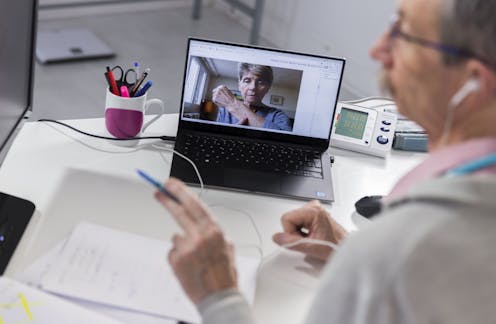
Amid the stress and confusion of coronavirus shutdowns and social distancing orders, it can seem to older patients as though everything is on pause. Clinics have postponed regular office visits. Patients worry about going to pharmacies and grocery stores. There’s even anecdotal evidence that people with serious issues such as chest pain are avoiding emergency rooms.
One important fact must not get overlooked amid this pandemic: Chronic health conditions still need attention.
If you had diabetes before the pandemic, you still have diabetes and should be monitoring your blood sugar levels. If you were advised to follow a low-salt diet before the pandemic to control your blood pressure, you still need to follow a low-salt diet during what my spouse calls “the duration.” If you had to check in with your doctor if your weight increased from underlying congestive heart failure, you still need to check your weight daily and call your doctor.
As I remind my geriatric patients, taking care of chronic conditions is even more critical right now as the new coronavirus raises the risk for people with underlying medical problems.
Lungs, heart and even kidneys
If you have chronic medical conditions and you become infected with the coronavirus, you’ll likely face an increased risk of developing severe symptoms.
The Centers for Disease Control and Prevention looked at a sample of U.S. patients with COVID-19 and found that 89% of those hospitalized in March had underlying conditions. The percentage rose to 94% for patients age 65 and older.
COVID-19 primarily affects the lungs, and people with lung diseases, such as COPD, have less “pulmonary reserve,” which is like having a backup generator waiting to kick in if the power goes out. So, what might have been a mild infection for someone else can develop into a severe infection for someone with lung problems.
Beyond the lungs, doctors and scientists are starting to see signs that COVID-19 may have devastating effects on the kidneys and heart. An extreme immune system response known as a cytokine storm can damage organs, and mini blood clots have developed in some patients.
High blood pressure, congestive heart failure or diabetes can also increase the risk of developing severe symptoms from COVID-19. In the CDC sample, 73% of older patients hospitalized with COVID-19 also had hypertension, about a third had diabetes and just over half had cardiovascular disease.
How to keep seeing your doctor
Managing chronic conditions amid a pandemic is not easy. It requires adjusting daily routines and dealing with new obstacles.
One of the challenges is medical appointments. During the pandemic, most geriatric clinics have postponed in-person visits for routine check-ups to avoid exposing patients or staff to the coronavirus. But that doesn’t mean your doctor isn’t there for you.
My clinic, for example, has transitioned most patient appointments to telehealth. This allows us to keep in touch with our patients and their symptoms and to adjust treatment plans in real time.
Online portals with “virtual waiting rooms” allow for video visits between patient and doctor. For patients who don’t have access to the internet or aren’t as comfortable with the technology, the telephone works, too. Patients can send photos of injuries. Over 90% of my clinic visits with my geriatric patients are now by telephone. We schedule time for the clinic appointment, the clinic staff registers the patient, and then I call the patient for the check-up.
I was in the middle of one of these visits recently when a patient asked me if I thought they should try telehealth. I was surprised by the question, and the patient was surprised by my answer – we were in the middle of a telehealth visit. I realized that the common picture of telehealth conveys a complex process, perhaps similar to calling a customer service line.
Telehealth is typically arranged with your own doctor – same doctor, same relationship – just a different physical connection.
What about prescription refills?
Even if a clinic no longer has routine patient appointments, the office is probably still staffed. Patients can call the clinic and may also be able to request medication refills online.
Patients should check if their insurance company will allow 90-day supplies rather the usual 30 days so they can limit trips to the pharmacy. Some pharmacies are also providing medication delivery or curbside pickup now so high-risk patients don’t have to walk inside the store.
Staying on a diet
Diet is often one of the toughest adjustments needed for controlling chronic medical conditions.
Watching what we eat can be even more challenging during a pandemic. Following a low-carb diet for diabetes, following a low-salt diet for congestive heart failure or following a low-cholesterol diet for heart disease isn’t simple when people are sitting at home with stocked pantries and unable to get to the grocery store for fresh produce.
To avoid snacking out of boredom, try creating a daily meal and snack schedule.
Staying hydrated can also help. Hormones that tell us when we need to drink something don’t respond as well as we age, so our bodies may need water rather than an unhealthy snack.
If getting to the grocery store is a challenge, check if the store has senior-only hours, delivery or curbside pickup. A friend, neighbor or family member might be able to go grocery shopping for you. Many people are eager to help and just need to be asked.
Staying out of the hospital
Even if you don’t get COVID-19, it is still critically important that you continue to manage your chronic medical conditions.
When chronic conditions aren’t managed, patients run a higher risk of ending up in the emergency room and hospital – places where COVID-19 patients are likely also being treated and that have become overburdened amid the pandemic.
One of the best ways to help them is to take care of yourself. Stay home. Stay well. Stay connected.
[Get facts about coronavirus and the latest research. Sign up for The Conversation’s newsletter.]
Laurie Archbald-Pannone does not work for, consult, own shares in or receive funding from any company or organisation that would benefit from this article, and has disclosed no relevant affiliations beyond their academic appointment.
from The Conversation – Articles (US) https://ift.tt/2VHGZVO




No comments: